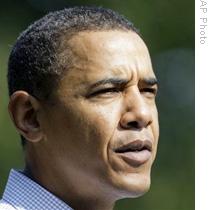Washington
01 October 2009
 |
| President Barack Obama (file photo) |
President Obama and 18 members of his national security team spent about three hours in the White House Situation Room Wednesday, assessing their Afghanistan policy. Details of the discussion were not released.
The president's press secretary, Robert Gibbs, says this is the second of five such meetings to be held over several weeks, to determine the best course in Afghanistan. "Let's get a firm strategy, let's discuss that, let's poke and prod it and ensure that we have done it the right way, then implement tactics to achieve that strategy, and part of those tactics are deciding resources," he said.
One choice Mr. Obama faces is whether to send more troops to Afghanistan to prevent the Taliban from regaining control, or to use special forces and unmanned spy planes to target al-Qaida in Pakistan.
The U.S. Commander in Afghanistan, Army General Stanley McChrystal, has said the U.S. will likely lose the war if the administration does not send more troops.
Pentagon Press Secretary Geoff Morrell says key military leaders all support the type of counterinsurgency strategy that has resulted in significant progress in Iraq in recent years. That approach requires a large number of troops to provide security and help the local government assert its authority and deliver services.
Morrell says Defense Secretary Robert Gates supports that approach. But the spokesman says much has happened since the president announced his strategy in March, and Gates wants a closer look. "He wants to have a thorough discussion with the president and the rest of the national security team about whether that does remain the best way to pursue our enemies in Afghanistan, and ultimately bring a level of peace and security there, so that it no longer poses a threat to us," he said.
Mr. Obama ordered an additional 21,000 forces into Afghanistan in March, boosting the U.S. total to 68,000. Troops from U.S. allies in the North Atlantic Treaty Organization bring the total to about 100,000.
Reports say General McChrystal wants between 30,000 and 40,000 additional troops. Morrell says Secretary Gates still has the commander's specific troop request "locked in his desk drawer," and it will stay there until a later stage of the strategy review.
Before Wednesday's meeting, presidential spokesman Robert Gibbs said another decision to be made is how to deal with insurgents in Pakistan. "Pakistan will play a big role in the discussions, both today and moving forward. Extremist elements that were in Afghanistan have now been pushed into the mountains and into Pakistan," he said.
Overall, Gibbs says the president's main goals in Afghanistan have not changed. "I think the president believes strongly that the goals that he outlined are still very key to our national security, that we have to disrupt, dismantle and destroy al-Qaida and its extremist allies," he said.
Support for the eight-year-old war is declining among Americans. Slightly more than half say the conflict is not worth the fight. And some Democrats in Congress have questioned whether escalating the war is wise.